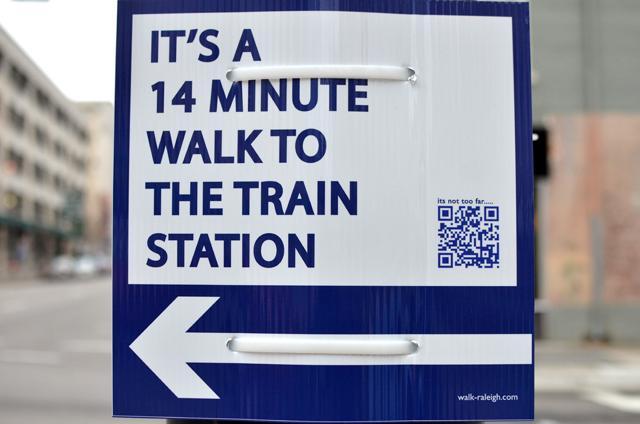
© NCSU Student Media 2012
One of landscape architecture graduate student Matt Tomasulo's walk Raleigh signs at the intersection of Wilmingnton and Hargett streets directs pedestrians to the train station.
Raleigh may not be a city famous for its “walkability” , but Matt Tomasulo and his network of strategically placed signs convincing Raleigh denizens to walk instead of drive are making an effort to change Raleigh’s reputation. Tomasulo sees his signs as part of a “Walk Raleigh” campaign.
Tomasulo is currently pursuing a masters degree in landscape architecture from N.C . State and a masters degree in city and regional planning from UNC Chapel Hill. He also has a small business called City Fabric that produces articles of clothing with city maps printed on them. Although there may not be an obvious link between fashion and walking, Tomasulo cites it as one of his inspirations for his “Walk Raleigh” campaign.
“We came up with the idea [for City Fabric from] data from real estate and urban and transportation planning.” Tomasulo said. ”It’s a civic minded product that’s meant to instigate and build community. That’s where ‘Walk Raleigh’ came from.”
Another inspiration for Walk Raleigh came to Tomasulo during a conversation with a friend who runs walking and dining tours in downtown Raleigh called ‘Taste Carolina.’
“He was saying that they’d sometimes drive from place to place and one day it was nice out and they walked. It was only a 10-minute walk. It blew us away that it was so short,” Tomasulo said. “After talking to him, I jumped on Google Maps and now they have this great tool called Walk that shows you how long it takes to walk places. I started to notice that it’s practically only a half hour to walk to any major point in downtown Raleigh.”
Tomasulo decided to test out his plan and created 27 signs that were intended for three different locations around Raleigh.
“[The three different locations] were targeted at three different demographics–students, young professionals, and people who work the 9-5 during the week,” Tomasulo said.
The signs were posted on the night of Jan. 18, 2012 and the response was almost immediate. Friends and followers of City Fabric shared Walk Raleigh, and one person submitted it to the Atlantic Cities online community in a comment on an article about “walkable cities. ” An editor liked the idea and featured it in an article on Feb. 6, 2012. The national coverage resulted in Tomasulo’s email inbox exploding with emails from cities, other media sources, health organizations, non-profits, and advocacy groups.
One of the inquirers was BBC. The news organization came to Raleigh and made a video expose that launched on Feb. 21, 2012. It was the most watched video on BBC’s site in the United States that day and landed in the top three that weekend. However, the news about Tomasulo’s campaign was not all positive. There was a lot of controversy.
“The BBC article got so many inquirers to the planning and development office about whether or not they were legal,” Tomasulo said. “We actually had to take them down briefly because they were done by a citizen. But the city staff liked them very much and worked diligently with Mitchell Silver, the planning and development director of Raleigh, to figure out a way to put them back up. He got it to be placed on the agenda of city council. They were voting to accept it as an educational pilot program for finding pedestrian ways of walking in the city. This was all on March 6th. In support of it being heard in front of the city council, I launched a digital petition campaign and within three days received 1,300 signatures of people in support and that was delivered to the city council.”
Despite the turmoil, Walk Raleigh is still going strong and pedestrians can see signs pointing them to Seaboard Station, Glenwood South, and even the N.C. Art Museum (which, at an hour walk on the greenway, is the longest).
“I think this project is great,” Gina Vaccaro, a senior in Fashion and Textile Management, said. “I love that he is taking the initiative to put up signs all around town. It reminds me that walking, for example to and from Centennial, is not an outrageous idea and can be done in less time than I imagined.”